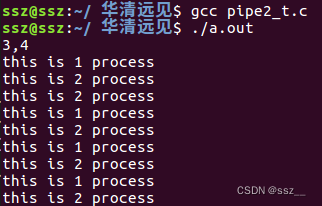进程间通信方式:
- 无名管道(pipe)
- 有名管道(fifo)
- 信号(signal)
- 共享内存(mmap)
- 套接字(socket)
无名管道:
在内核里面开辟一片内存,进程1和进程2都可以通过这片内存进行通信

无名管道特点:
- 只能用于具有亲缘关系的进程之间的通信(比如父子进程、兄弟进程)
- 单工的通信模式,具有固定的读端和写端(只能一个进程写、一个进程读,不能反过来)
- 无名管道创建时会返回两个文件描述符,分别用于读写管道(一个进程只能用一个描述符,因为是单工通信)
无名管道创建-pipe
#include <unistd.h>
int pipe(int pfd[2]);
- 成功时返回0,失败时返回EOF
- pfd包含两个元素的整形数组,用来保存文件描述符
- pfd[0]用于读管道;pfd[1]用于写管道

示例代码:
#include <stdio.h>
#include <unistd.h>
#include <string.h>
int main()
{int pfd[2];int re;char buf[20] = {0};__pid_t pid;re = pipe(pfd);if(re < 0){perror("pipe");return 0;}printf("%d,%d\n",pfd[0],pfd[1]);pid = fork();if(pid < 0){perror("fork");return 0;}else if(pid == 0)//子进程{close(pfd[0]);while (1){strcpy(buf,"hahahahhahah");write(pfd[1],buf,strlen(buf));sleep(1);}}else // 父进程{close(pfd[1]);while (1){re = read(pfd[0],buf,20);if(re > 0){printf("red pipe=%s\n",buf);}} }
}运行结果:

创建两个子线程,两个子线程对管道就行写,一个父进程对管道进行读,示例代码:
#include <stdio.h>
#include <unistd.h>
#include <string.h>
int main()
{int pfd[2];int re,i;char buf[40] = {0};__pid_t pid;re = pipe(pfd);if(re < 0){perror("pipe");return 0;}printf("%d,%d\n",pfd[0],pfd[1]);for(i = 0;i < 2;i++){pid = fork();if(pid < 0){perror("fork");return 0;}else if(pid > 0)// 父进程{}else //子进程{break; }}if (i == 2)//父进程执行到这里{close(pfd[1]);while (1){memset(buf,0,40);re = read(pfd[0],buf,20);if(re > 0){printf("%s\n",buf);}}return 0;}if (i == 1){close(pfd[0]);while (1){strcpy(buf,"this is 2 process");write(pfd[1],buf,strlen(buf));usleep(930000);}return 0;}if (i == 0){close(pfd[0]);while (1){strcpy(buf,"this is 1 process");write(pfd[1],buf,strlen(buf));sleep(1);}return 0;}
}运行结果:

无名管道读写特性:
1.读管道:
(1)管道中有数据,read返回实际读到的字节数
(2)管道中无数据:
- 管道写端被全部关闭(就是读写全关闭),read返回0(好像读到文件结尾)
- 写端没有全部被关闭(就是把读关闭,没有关闭写),read阻塞等待(不就的将来可能有数据抵达,此时让出cpu)
2.写管道:
(1)管道读端全部被关闭(就是读写全关闭),进程异常终止(也可以使用SIGPIPE信号,使进程不终止)
(2)管道读端没有全部关闭(就是把写关闭,没有关闭读):
- 管道已满,write阻塞(管道是64k)
- 管道未满,write将数据写入,并返回实际写入的字节数
有名管道(fifo)特点:
- 有名管道可以使非亲缘的两个进程互相通信
- 通过路径名称来操作,在文件系统中可见,但内容存放在内存中(不是磁盘文件)
- 文件IO来操作有名管道
- 遵循先进先出规则
- 不支持leek操作
- 单工读写
有名管道创建-mkfifo:
#include <unistd.h>
#include <fcntl.h>
int mkfifo(const char *path,mode_t mode);
- 成功时返回0,失败时返回EOF
- path创建的管道文件路径
- mode管道文件的权限,如666
示例代码:
向文件写:
#include <sys/types.h>
#include <sys/stat.h>
#include <stdio.h>
#include <unistd.h>
#include <string.h>
#include <fcntl.h>
int main()
{int re;int fd;char buf[32];re = mkfifo("./myfifo",0666);if (re < 0){perror("mkfifo");// return 0;}fd = open("./myfifo",O_WRONLY);if (fd < 0){perror("open");return 0;}while (1){fgets(buf,32,stdin);write(fd,buf,strlen(buf));}
}
向文件读:
#include <sys/types.h>
#include <sys/stat.h>
#include <stdio.h>
#include <unistd.h>
#include <string.h>
#include <fcntl.h>
#include <stdlib.h>
int main()
{int re;int fd;char buf[32];fd = open("./myfifo",O_RDONLY);if (fd < 0){perror("open");// return 0;}while (1){re = read(fd,buf,32);if (re > 0){printf("read fifo=%s\n",buf);}else{exit(0);}}
}
运行结果:


open函数四种状态
open(const char *path,O_RDONLY);
open(const char *path,O_RDONLY|O_NONBLOCK);
open(const char *path,O_WRONLY);
open(const char *path,O_WRONLY|O_NONBLOCK);
注意事项:
- 就是程序不能以O_RDWR(读写)模式打开FIFO文件进行读写操作,而其行为也未明确定义,因为如一个管道以读/写方式打开,进程可以读回自己的输出,同时我们通常使用FIFO只是为了单向的传递数据
- 第二个参数中的选项O_NONBLOCK,选项O_NONBLOCK表示非阻塞,加上这个选项后,表示open调用是非阻塞的,如果没有这个选项,则表示open调用是阻塞的
- 对于以只读方式(O_RDONLY)打开的FIFO文件,如果open调用是阻塞的(即第二个参数为O_RDONLY),除非有一个进程以写方式打开同一个FIFO,否则它不会返回;如果open调用是非阻塞的(即第二个参数为O_RDONLY|O_NONBLOCK),则即使没有其他进程以写方式打开同一个FIFO文件,open调用将成功并立即返回。但如果没有其他进程以只读方式打开同一个FIFO文件,open调用将返回-1,并且FIFO也不会被打开
- 数据完整性,如果有多个进程写同一个管道,使用O_WRONLY方式打开管道,如果写入的数据长度小于等于PIPE_BUF(4K),那么或者写入全部字节,或者一个字节都不写入,系统就可以确保数据绝不会交错在一起。

)









灰色预测】)

)





